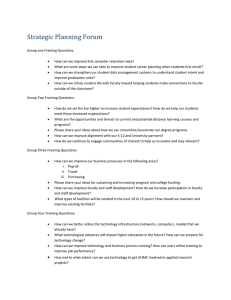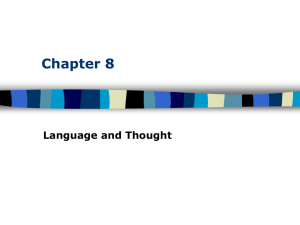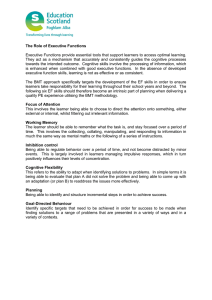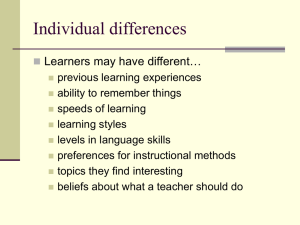Different ways of thinking about learning NZCER
advertisement
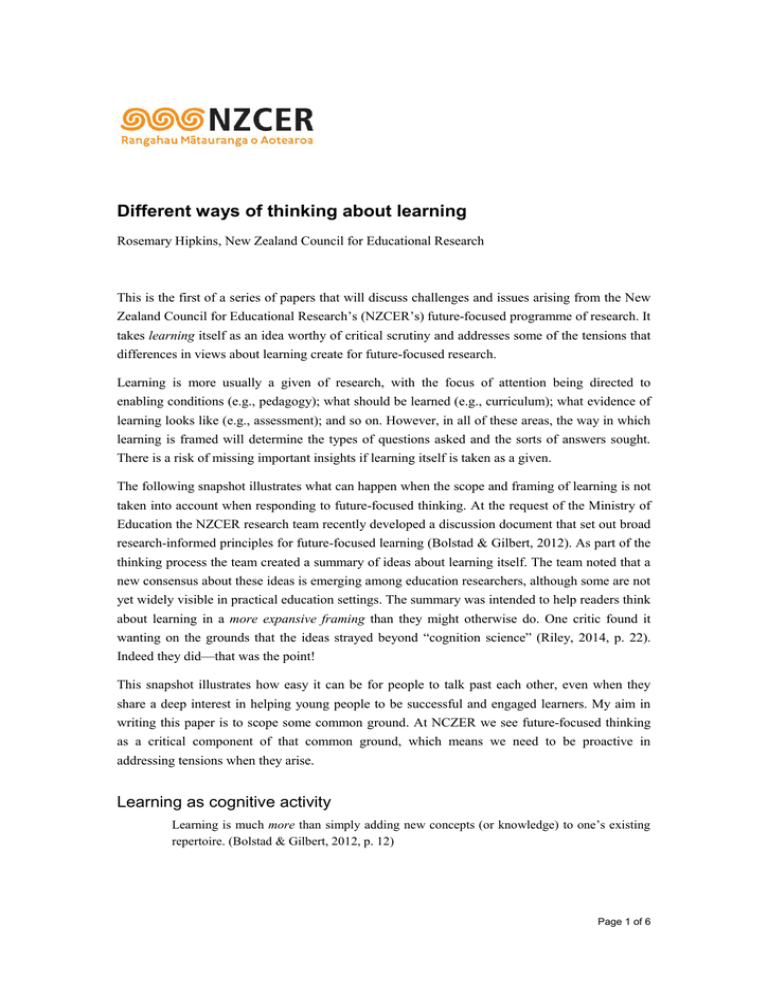
Different ways of thinking about learning Rosemary Hipkins, New Zealand Council for Educational Research This is the first of a series of papers that will discuss challenges and issues arising from the New Zealand Council for Educational Research’s (NZCER’s) future-focused programme of research. It takes learning itself as an idea worthy of critical scrutiny and addresses some of the tensions that differences in views about learning create for future-focused research. Learning is more usually a given of research, with the focus of attention being directed to enabling conditions (e.g., pedagogy); what should be learned (e.g., curriculum); what evidence of learning looks like (e.g., assessment); and so on. However, in all of these areas, the way in which learning is framed will determine the types of questions asked and the sorts of answers sought. There is a risk of missing important insights if learning itself is taken as a given. The following snapshot illustrates what can happen when the scope and framing of learning is not taken into account when responding to future-focused thinking. At the request of the Ministry of Education the NZCER research team recently developed a discussion document that set out broad research-informed principles for future-focused learning (Bolstad & Gilbert, 2012). As part of the thinking process the team created a summary of ideas about learning itself. The team noted that a new consensus about these ideas is emerging among education researchers, although some are not yet widely visible in practical education settings. The summary was intended to help readers think about learning in a more expansive framing than they might otherwise do. One critic found it wanting on the grounds that the ideas strayed beyond “cognition science” (Riley, 2014, p. 22). Indeed they did—that was the point! This snapshot illustrates how easy it can be for people to talk past each other, even when they share a deep interest in helping young people to be successful and engaged learners. My aim in writing this paper is to scope some common ground. At NCZER we see future-focused thinking as a critical component of that common ground, which means we need to be proactive in addressing tensions when they arise. Learning as cognitive activity Learning is much more than simply adding new concepts (or knowledge) to one’s existing repertoire. (Bolstad & Gilbert, 2012, p. 12) Page 1 of 6 The brain is actively involved in acts of learning. This probably seems so obvious that it hardly needs stating at all. However this obviousness can obscure the limitations of framing learning as only entailing cognitive activity. It is important to consider how brain-based perspectives shape research questions and subsequent pedagogical discussions about learning. Brain-based (rational) thinking is the “cognitive” activity that is the familiar focus of much research about learning. Evidence of successful learning is sought by assessing cognitive gains in important basic skills (e.g., literacy, numeracy) or expansions of content knowledge. Ideally these basic cognitive gains will be accompanied by evidence of deeper understanding—the higher-order cognitive activities that are displayed as critical and creative thinking, the ability to apply knowledge to new contexts, and so on. It follows that researchers seek robust evidence of knowledge and skill gains when researching questions about learning. Long-established assessment traditions support this approach by providing familiar ways to gather data that are demonstrably valid and reliable within this specific framing of learning. This framing of learning is fine as far as it goes, but it is not sufficiently expansive. The following sections discuss the “much more” alluded to in the quote at the beginning of this section. The experiential nature of learning Experiences are critical to learning. Just as learners need knowledge to think with, they also need experiences to think with. Children’s thinking and learning processes are similar to those of adults, but their learning and knowledge has less depth because they have fewer experiences to draw on when processing new ideas or situations. (Bolstad & Gilbert, 2012, p. 12) In traditional assessments, knowledge is usually divided up in ways that don’t mirror our “whole” experiences of the real world. This is one obvious limitation of only seeking cognitive gains as evidence of successful learning, but it is not the only one. Imagine for a moment that new methods of assessment do not atomise knowledge. These hypothetical assessments are cognitively rich and broad and “cover” knowledge across the curriculum. Assuming this is practically possible, would evidence of learning—as gathered by these new assessments—transcend the limitations of current evidence gathering? Would they give us a truly comprehensive picture of learning? Many scholars of learning would still answer “no” to this question. One reason might be that cognitive gains will not necessarily predict what people can do with their learning. Acting with what we think we know requires interaction between our brain, our body, and aspects of our surroundings. The frame of reference for learning needs to expand to encompass the part that experiences play. Again there is not much that is inherently challenging in this idea per se. However there are some more challenging ideas associated with this somewhat expanded framing of learning. One limitation of a cognitive framing of learning might be summed up by a rather gruesome phrase, “brain in a vat”, used by the philosopher Bruno Latour when discussing the mistaken Page 2 of 6 notion that rational thinking can somehow be bracketed off from our messy bodies and lives (Latour, 1999). Clearly our brains do not sit in isolation in some sort of special vat. They can’t function without the rest of the body. There is now strong evidence from neuroscience that what’s happening in our bodies directly impacts what and how well we can learn. “Embodied” thinking alludes to this idea directly. An example might be how our hands “remember” manual skills once we have acquired these, bearing in mind that they cannot be acquired simply by thinking about what the skill might entail. The role of embodied thinking in learning is a specific focus for some learning researchers. One challenge they face is that cognitive gains are not adequate evidence of learning. Assessment of athletic performance provides one potential way of thinking about assessing embodied learning. Another limitation of a cognitive framing of learning comes from the idea cited at the beginning of this section. If experiences are things individuals think with, it follows that the actual experiences each person has will directly impact on how their brain structures their meaning making. Students bring widely varying experiences to school. The fortunate ones come with a rich “library of experiences” on which to draw as they learn. Others need to build their libraries with the help of school. This could be the most important contribution that subjects such as science make to learning in the early years (Bull, Gilbert, Barwick, Hipkins, & Baker, 2010; Gallas, 1995). The phrase “opportunities to learn” signals another challenge that follows from explicit acknowledgement of the part that experiences play in learning. This phrase takes on a different meaning in different framings of learning. If the frame of reference is restricted to specific cognitive gains, learning opportunities can be assumed to be the same for all who experience them—a sort of “level playing field” argument. But if personal experiences are integral to learning it follows that the playing field cannot be level. Different learners bring different backgrounds and capabilities to learning. Depending on how their previous experiences influence their thinking and meaning making, they might understand a task in quite different ways, use different reasoning or skills in trying to achieve the learning, and/or understand what constitutes “success” in quite different terms. It follows that offering equitable opportunities to learn will require the teachers to take these differences into account. Learning as a social activity Learning involves interaction—trying out and testing ideas with others. Some or all of it takes place in the context of relationships with other human beings. Sometimes these are people who know more than the learner, sometimes they know less, and sometimes they are learning together. A precondition for learning, then, is that the learner feels acknowledged and valued by their co-learners, and that they feel they belong to, or are part of the culture of the learning context. (Bolstad & Gilbert, 2012, p. 12) This paper has argued that individual brain-based cognition is an inadequate frame of reference for how people learn in general, and therefore there will be limitations on how useful evidence of this type can be for determining how best to support learning for different young people in Page 3 of 6 different contexts. In this section some implications of framing learning as a social act are briefly outlined. Some learning with a high social value might not be possible when individuals learn alone. “Thinking in the spaces between people” is an idea associated with an expanded framing of learning. When people bring different ideas and experiences to the group, there is richer, more diverse material to think with, and the group might accomplish learning that none of the individuals could accomplish alone. This type of collective learning is increasingly valued in work contexts, in team sports, and in other types of creative and community endeavours. When contributions flow freely, it may not possible to disentangle and attribute specific gains to specific individuals. Traditional evidence of learning, as individual cognitive gains, is neither adequate nor appropriate in such circumstances. Furthermore, thinking cannot be the only skill set considered because constructive group interactions require the ability to listen, to interact appropriately, and so on. The last sentence in the idea cited at the start of this section brings together the concepts of embodied cognition and thinking with experiences. Emotions impact cognition directly. The brain is part of the body. It will, for example, experience the biological responses triggered by adrenaline. The connection between feelings and thinking is so strong that it is not uncommon to indelibly “learn” something as a direct response to a powerful experience, regardless of whether that experience is negative or positive. Less dramatically, emotions also impact learning indirectly. Cognitive activity is effortful and is more likely to be accomplished in circumstances where negative emotions do not get in the way. The sense of being “paralysed” when trying to think in stressful circumstances illustrates this phenomenon. The importance of creating a safe emotional climate for learning follows logically from a framing of learning that acknowledges emotions as well as cognition. More subtly, each individual’s sense of belonging will impact their cognition. Here an expansive framing of “opportunities to learn” is again invoked. Individuals will react differently in the same social setting. These differences will be tempered by their previous life experiences. The idea of “cultural responsiveness” comes from this expanded framing of learning. This idea emphasises the role of the teacher in recognising and responding to students’ own cultural referents (e.g., different world views and values). Motivation as a key enabler Learners have to want to learn the material. They have to be able to see a purpose to learning it—both in the short term and in the longer-term sense of seeing how this material will allow them to contribute to something beyond themselves. (Bolstad & Gilbert, 2012, p. 12) As just outlined, the role of emotions in learning should not be underestimated. A safe emotional climate in the classroom is a necessary foundation for the risky business of learning and growing as a person. No one else can make an individual’s cognitive connections for them. Even when the Page 4 of 6 framing of learning is expanded in the ways discussed in this short paper, the brain does need to make robust connections for learning to “stick”. Dispositions—that complex mix of attitudes, values, and personal beliefs—play a critical role in enabling learning. Having a clear sense of purpose for the intended learning comes into play here. Individuals are more likely to be successful in their learning endeavours if they see good reason to put in the necessary effort and when they value the learning goal. Gathering evidence of students’ learning dispositions can be done but requires care. Inferring dispositions from observed behaviour is fraught because values and beliefs are essentially private (Deakin Crick, 2008). However considerable research effort has been invested in understanding the different variables that contribute to students’ motivation to learn, with innovative selfassessment tools being developed. How you see yourself as a learner is an important variable when considering learning dispositions. Attribution theories point to the importance of framing learning success as attainable with effort, rather than reliant on ability (Dweck & Leggett, 1988). Thinking only “bright” people can be successful learners can cause some students to give up too readily. It can also become selffulfilling when teachers withhold challenging learning experiences on the grounds that certain types of students won’t be able to master them. The recent emphasis on learning to learn reflects this expansive framing of how learning can be best supported. Conversations about learning itself (metacognitive conversations) help students build awareness of their own feelings and beliefs, with the aim of supporting them to build positive learning dispositions. Personalising learning Learning has to be a personalised—not a standardised—experience. Learners have to feel in charge of their own learning. They need to feel that they know what they are doing, and that they can control the pace of their learning. They need to ‘get into it’ enough to get a sense of flow and progress; they need the right amount of challenge (not so much that it is beyond them, but not so little that it is boring); and they need feedback along the way (not just at the end of the course). Young children need help to do this, but to learn more (and become better learners), they need to be able to regulate their own learning and become less and less reliant on the teacher to regulate the pace and goals of learning. (Bolstad & Gilbert, 2012, p. 12) Finally I turn to the idea that drew the strongest critique from Riley (2014). The focus of the preceding sections outlines a range of reasons why enabling learning conditions cannot be “one size fits all”. A focus on conditions in which cognition might occur, all other things being equal, is too restricting. All other things are not equal and a great deal is now known about why not— with associated suggestions about how to make learning more equitable. Critique such as Riley’s appears to assume that personalising learning is an either/or choice. Either the teacher directs the learning action, or the student does. This is a limited reading of the intent of personalisation. Indeed, the enabling conditions outlined in the preceding sections imply Page 5 of 6 a need for deeper teacher knowledge and skills. What changes most is the understanding of opportunities to learn. Sound traditional teaching will support some students but perhaps not others. Greater responsivity to the specific challenges faced by different learners is a key role for the teacher. The preceding sections also highlight the active, volitional nature of meaningful learning. That’s why the learning-to-learn dimensions—feeling in charge of one’s own learning—are also emphasised in the idea of personalisation. Again—just to be clear—the teacher does not abdicate responsibility. What changes is that they use their expertise to set up conditions where responsibility can be shared. This allows students to build their dispositions to go on being learners when teachers are no longer around. The New Zealand Curriculum aspires for all our young people to be and become “confident, connected, actively involved, lifelong learners” (Ministry of Education, 2007, p. 8). Only by taking a more expansive view of what we mean by learning is this future-focused vision likely to be realised. References Bolstad, R., & Gilbert, J. (with McDowall, S., Bull, A., Boyd, S., & Hipkins, R). (2012). Supporting future-oriented learning and teaching: A New Zealand perspective. Retrieved from http://www.educationcounts.govt.nz/publications/schooling/109306 Bull, A., Gilbert, J., Barwick, H., Hipkins, R., & Baker, R. (2010). Inspired by science: A paper commissioned by the Royal Society and the Prime Minister’s science advisor. Wellington: New Zealand Council for Educational Research. Available at http://www.nzcer.org.nz/default.php?products_id=2647 Deakin Crick, R. (2008). Key competencies for education in a European context: Narratives of accountability or care. European Educational Research Journal, 7(3), 311–318. Dweck, C., & Leggett, E. (1988). A social-cognitive approach to motivation and personality. Psychological Review, 92(2), 256–273. Gallas, K. (1995). Talking their way into science: Hearing children's questions and theories, responding with curricula. New York: Teachers College Press. Latour, B. (1999). Pandora's hope: Essays on the reality of science studies. Cambridge, MA: Harvard University Press. Ministry of Education. (2007). The New Zealand curriculum. Wellington: Learning Media. Riley, B. (2014). Science, data and decisions in New Zealand’s education system. Wellington: Ian Axford (New Zealand) Fellowships in Public Policy. Page 6 of 6
